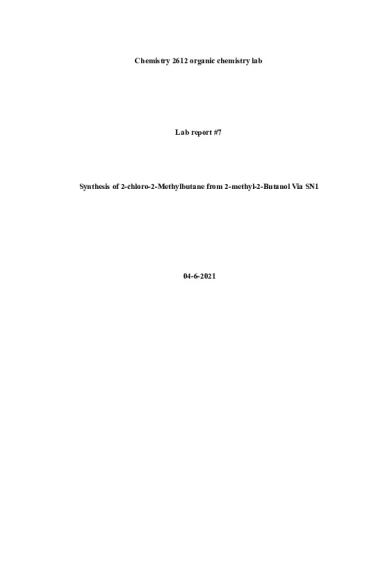SN1 - lap org 1 lab PDF

| Title | SN1 - lap org 1 lab |
|---|---|
| Author | Ahmed Mamoori |
| Course | Organic Chemistry I Laboratory |
| Institution | The University of Texas at San Antonio |
| Pages | 10 |
| File Size | 337.6 KB |
| File Type | |
| Total Downloads | 101 |
| Total Views | 143 |
Summary
lap org 1 lab...
Description
Chemistry 2612 organic chemistry lab
Lab report #7
Synthesis of 2-chloro-2-Methylbutane from 2-methyl-2-Butanol Via SN1
04-6-2021
Introduction The purpose of this experiment is to synthesis 2-chloro-2-Methylbutane from 2-methyl-2Butanol Via SN1. The first set in the SN1 reaction is protonation which leads to the formation of carbocation intermediate, SN1 reaction allows rearmament of the molecule either H or R group to form the most stable product. SN1 reaction favors the formation tertiary substrate and secondary substate duo to hyperconjugation and inductive effect, methyl substrate doesn’t work well with SN1 reaction duo to the stability of carbocation. SN1 reaction stereochemistry is a 50/50 remixture which is also a multi-step mechanism and the rate of the reaction is unimolecular. SN1 reactions use polar protic solvents and SN1 involves weak nucleophiles. SN1 is first order with respect to the substrate and nucleophile. SN1 used in the experiment by Protonating 2-methyl-2-butanol using HCl making better leaving (H2O), lead to the formation of carbocation and nucleophile. The carbocation attacked by Nucleophilic attack using chlorine result information of 2-chloro-2-methylbtane.
Reaction Mechanism First step:
Second step:
Third step
Chemical Properties and Safety 2-chloro-2-methylbtane
Boing point =86°C Density= 0.866 g/cm3 Hazards include Irritant of skin, eyes, ingestion, and inhalation also flammable.
Sodium chloride
Boing point = 1,465°C Density= 1.2 g/mL Hazards include Irritant of skin, eyes, ingestion, and inhalation.
2-methly-2-butanol
Boing point =102°C Density= 0.8 g/mL Hazards include Irritant of skin, eyes, ingestion, and inhalation
Experimental Section 10. mL of 2-methyl-2-butanol and 25 mL of concentrated HCl added in a separatory funnel. Stopper and shake, swirl, and VENT for 10 minutes. The product(density is 0.86 g/mL) is the top layer which is washed and extracted by darning the bottom layer, 5-10 ml of cold sodium bicarbonate (NaHCO3) added to the mixture then swirl, VENT, and drain the bottom layer. 10 mL of water, swirl, vent, and drain the bottom layer than 10. mL of NaCl, swirl, vent, and drain the bottom layer again. The top layer poured out into a clean beaker and dried with sodium sulfate. Product is Transferred to obtain weight for yield then analyze by IR, then conduct the silver nitrate and sodium iodide tests.
Data and Observations
Calculation Percent Yield =
actual yield × 100% theoretical yield
10. mL of 2-methyl-2-butanol D =0.8 g/mL
10ml 0.8g x 1 1 ml
88.15g/mol
= 8g
8g 1 mol x = 0.091 1 88.15g
25 mL of concentrated HCl D= 1.2 g/mL
25ml 1.2g x 1 1ml 30g 1
x
36.458g/mol
=30g
1mol 36.458g
= 0.822
8.765g. 2-chloro-2-methylbtane
actual
106.59 g/mol
8.765 1mol x 1 106.59g
Percent Yield =
= 0.082
0.082 × 100% 0.091
= 90.11%
Discussion and Conclusions In conclusion, this experiment is conducted to synthesis 2-chloro-2-Methylbutane from 2-methyl-2-Butanol by SN2 reaction mechanism. The protonation of methyl-2-Butanol to which result in carbocation, then Nucleophilic attack which leads to the formation of 2-chloro-2Methylbutane. The product yield is 90% which is high, there must be error conduction in this experiment which leads to the failure of synthesis also Must be an error in the calculation of the theoretical value which produced such a high percentage. The HNMR of the 2-methyl-2-Butanol show singlet around 1.4ppm and 2-chloro-2-Methylbutane don’t have that singlet because it was attached to the OH which got protonated to form a better-leaving group. IN the IR test the OH peak around 3400 cm-1 disappeared after H-Cl reacted with 1-butanol to form 2-chloro-2Methylbutane which shows different peak forming....
Similar Free PDFs

SN1 - lap org 1 lab
- 10 Pages

SN1 SN2 lab report
- 8 Pages

Org lab 3 pdf
- 7 Pages

Lap report 1
- 4 Pages

Sist.Inf. Org. API 1
- 1 Pages

Tutorial 1 - Bus Org
- 2 Pages

Lap tapesingkong
- 11 Pages

Reacciones SN1
- 4 Pages

Lap Motor DC Kel 23
- 29 Pages

Chimie - SN1:SN2
- 3 Pages

SN1-vs-SN2
- 1 Pages

Lap M5 nonononononoo
- 24 Pages

Lap work 1 - Lecture notes 1-7
- 6 Pages
Popular Institutions
- Tinajero National High School - Annex
- Politeknik Caltex Riau
- Yokohama City University
- SGT University
- University of Al-Qadisiyah
- Divine Word College of Vigan
- Techniek College Rotterdam
- Universidade de Santiago
- Universiti Teknologi MARA Cawangan Johor Kampus Pasir Gudang
- Poltekkes Kemenkes Yogyakarta
- Baguio City National High School
- Colegio san marcos
- preparatoria uno
- Centro de Bachillerato Tecnológico Industrial y de Servicios No. 107
- Dalian Maritime University
- Quang Trung Secondary School
- Colegio Tecnológico en Informática
- Corporación Regional de Educación Superior
- Grupo CEDVA
- Dar Al Uloom University
- Centro de Estudios Preuniversitarios de la Universidad Nacional de Ingeniería
- 上智大学
- Aakash International School, Nuna Majara
- San Felipe Neri Catholic School
- Kang Chiao International School - New Taipei City
- Misamis Occidental National High School
- Institución Educativa Escuela Normal Juan Ladrilleros
- Kolehiyo ng Pantukan
- Batanes State College
- Instituto Continental
- Sekolah Menengah Kejuruan Kesehatan Kaltara (Tarakan)
- Colegio de La Inmaculada Concepcion - Cebu


